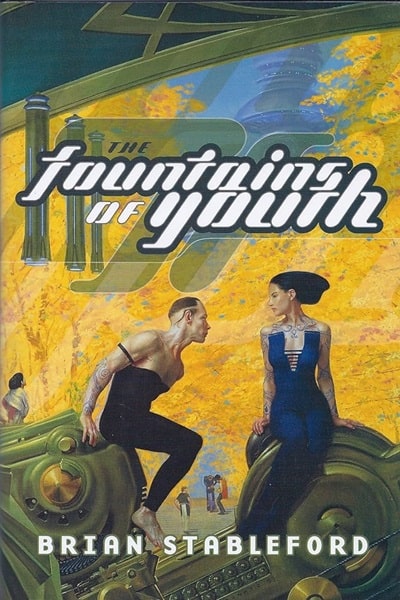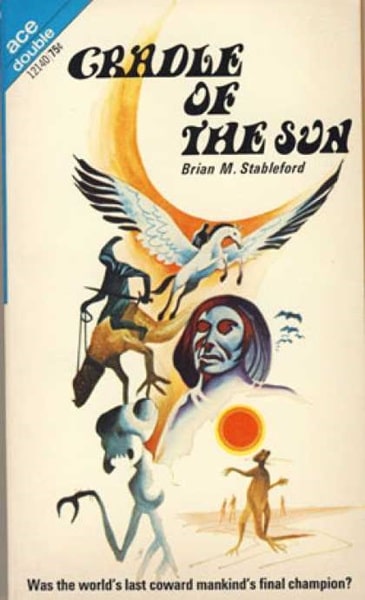Brian Stableford, July 25, 1948 – February 24, 2024
 |
 |
 |
The Last Days of the Edge of the World (Ace Books, September 1985), The Empire of Fear
(Ballantine Books, October 1993), and The Werewolves of London (Carroll & Graf,
November 1994). Covers by Don Maitz, uncredited, and uncredited
Perhaps it is recency bias, or poor memory, or some other artifact of how human minds process data, but I cannot recall a time when the science fiction field lost so many significant writers in such a short time. At any rate, I know I have never written so many obituaries for significant SF writers in such a short time!
Brian Stableford died February 24, after an extended period of poor health. He was 75. I never met him, and only corresponded with him as part of a mailing list (he did recommend a time viewer story to me!), but I have read his work extensively, and even so, have barely scratched the surface.
His bibliography is, frankly, intimidating. He wrote dozens of SF and Fantasy novels, as many or more short stories. He was a very prolific anthologist, with a particular interest in early SF, and, especially, in French works of fantastika. He translated countless* French novels and stories into English. He wrote hundreds of book reviews and essays, and published many non-fiction books. And for all that prolificity, his work was of exceptional quality.
[Click the images for larger versions.]
 |
 |
 |
 |
Hooded Swan novels by Brian M. Stableford: Rhapsody in Black, Promised Land,
The Paradise Game, and Swan Song (DAW Books, 1973-1975). Covers by Kelly Freas
He began publishing fiction as a teenager — his first story, a collaboration with Craig A. Mackintosh as by Brian Craig, appeared in Science Fantasy in 1965. His first novel, an Ace Double half called Cradle of the Sun, came out in 1969. Throughout the 1970s he wrote extensively for DAW books, several different series, of which my favorites were the Hooded Swan books and the stories of the Daedalus Mission. Stableford had degrees in Biology and Sociology, and these subjects were fundamental to his SF, including these early DAW books.
This early work was imaginative and entertaining but rather routinely plotted and written. But he kept improving. I began to take greater notice of him with a varied set of stories beginning with 1988’s The Empire of Fear and continuing through the ’90s with works such as “The Hunger and Ecstasy of Vampires,” The Werewolves of London, and more. These show his fascination with early SF (particularly Scientific Romance á la H. G. Wells) as they tended to be set in Victorian alternate histories, and dealt variously with vampires and werewolves given science fictional rationales.
 |
 |
 |
Three novels in the Emortality series: The Cassandra Complex, Inherit the Earth,
The Fountains of Youth (Tor Books, 1998-2001). Covers by Alan Pollack and Donato
At about the same time, and extending into the 2000s, he produced a long future history, with six novels and several more shorter stories, involving radical use of biotech on Earth and other planets, leading to the abolition of death, so that the novel sequence is collectively titled Emortality. These were the Stableford books I dealt with most deeply — they are major work, extremely intelligent, rigorously worked out, always interesting and uncompromising.
His short fiction was excellent as well — “The Hunger and Ecstasy of Vampires” won the BSFA Award, and he received a Hugo nomination for “Les Fleurs du Mal” and a Nebula ballot position for “Mortimer Gray’s ‘History of Death'” and was on the Sturgeon shortlist for “The Age of Innocence.” I am particularly fond of his 1998 story “The Pipes of Pan.”
 |
 |
 |
A Clash of Symbols: The Triumph of James Blish (Borgo Press: The Milford Series #24,
October 1979), The Third Millennium: A History of the World AD 2000-3000 (Paladin,
February 1988, cover by Chris Moore), Masters of Science Fiction: Essays on Six
Science Fiction Authors (Borgo Press: The Milford Series #32, December 1981)
His vast array of nonfiction is very worthwhile as well. He wrote an important book on the fiction of James Blish, A Clash of Symbols, and he collaborated with David Langford on an intriguing piece of futuristic speculation: The Third Millennium. Masters of Science Fiction is essays on Edmond Hamilton, Leigh Brackett, Barry N. Malzberg, Robert Silverberg, Kurt Vonnegut, and Mack Reynolds, and Scientific Romance in Britain: 1890-1950 is an authoritative look at that supremely British mode of SF.
Much of his later career was devoted to his massive project to bring early French works of fantastika to the attention of English-language readers — numerous anthologies and novels, with stories dating back to at least the 17th century. But he also continued to publish a great deal of his own fiction.
 |
 |
 |
Cradle of the Sun (Ace Books, 1969), The Blind Worm (Ace, February 1970), and
The City of The Sun (DAW, May 1978). Covers by Jack Gaughan, Gray Morrow, Don Maitz
I don’t think Brian Stableford’s work has been appreciated to the degree it deserves, perhaps partly because there was so much of it. But he has left a legacy of excellent SF and Fantasy on his own, plus first-rate critical work and an impressive body of translated stories that will ultimately be a great resource. He will be gravely missed.
I have published a number of reviews of Stableford’s work:
Cradle of the Sun
The Blind Worm
The Omega Expedition, Dark Ararat, and several short stories
(*Technically not quite countless — Phil Stephenson-Payne has counted them and the total comes to 378, with possibly some remaining in the pipeline.)
Rich Horton’s last article for us was Great Books Make You Cry. His website is Strange at Ecbatan. Rich has written over 200 articles for Black Gate, see them all here.
The Hooded Swan books were the first Stablefords I read, followed by the Daedalus Expedition series. As you say, in many ways they are standard adventure/space opera (which I confess is something that I like about them) but Stableford’s intelligence was such that he couldn’t really produce anything that was just routine; everything of his that I’ve read always had some extra juice in it.
Yet another reason to say, “Bless you, Donald Wollheim.”
Those I think are my only Stablefords. Unread as I am missing I think book 5 in the series. Sad news to hear of another authors passing.
Another long echo down the corridors of my mental library. I just pulled The Last Days of the Edge of the World off my book shelves to keep me company while I think upon Mr. Stableford’s works.
And I would snag every one of those Hooded Swan books for the Frank Kelly Freas covers as well as for the “pacifist space opera” novels contained within.
Thank you, Mr. Horton, for bringing Mr. Stableford back to mind, no matter the reason.
Those were some of Kelly Freas’ best work, I think.
I only discovered Stableford’s publishing company, Snuggly Books, a few years ago. That’s the kind of small press that I wish we had more of, in this case one that was reprinting many older works (especially fin de siècle) in translation. Obviously a labor of love for Stableford, let’s hope the publisher and its inventory can persist for a while longer.
Yes, sad to see another death in the field. I, too, remember those many DAW books with Brian Stableford’s name on them, and how they were all so interesting and well written. Thanks for this appreciation of his work, Rich.
A shame – I loved the Grainger series. I always felt it had a Film Noir feel to it and imagined Grainger being played by Humphrey Bogart.
I had a great time with Empire Of Fear and the Dover anthology Scientific Romance that was immensely enriched by his notes. I’ve been buying up as much of his work as I can.
I have a constant fear hovering around me about print on demand books getting deleted (as they often do) and that’s a particular problem because most of his work is from Wildside, Snuggly and Black Coat (despite all his decades in traditional print), hundreds of books. I wonder if those more recent trilogies were intended as a single book but split up for cost reasons?
There’s a vanishingly small number of reviews of his novels from this era of his career and I know that is partly because the overwhelming amount of it but I wonder why his older fans rarely sampled any of this. It’s quite upsetting because I’ve never heard about there being any decline in quality. Wish I had been fast enough to read more of it.
There’s a good interview with him on youtube in france. I wish there had been more video or audio interviews.